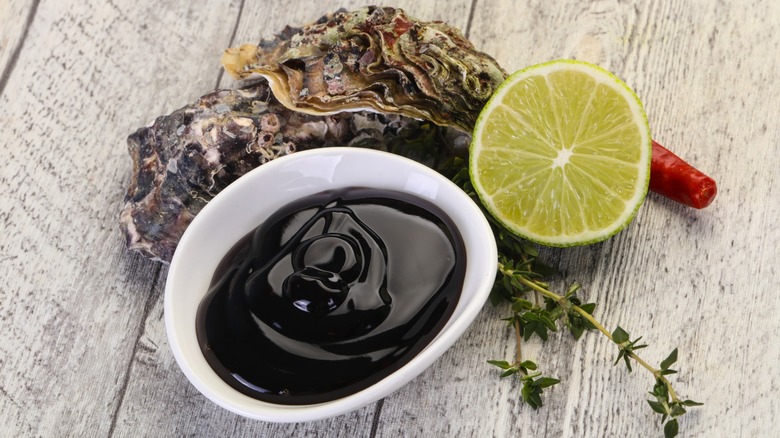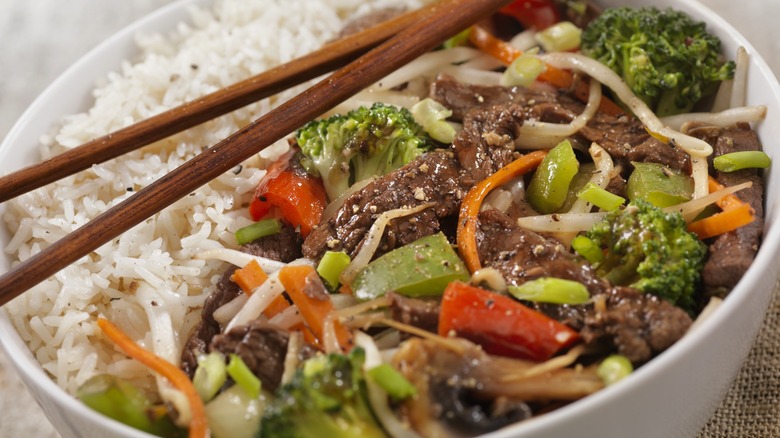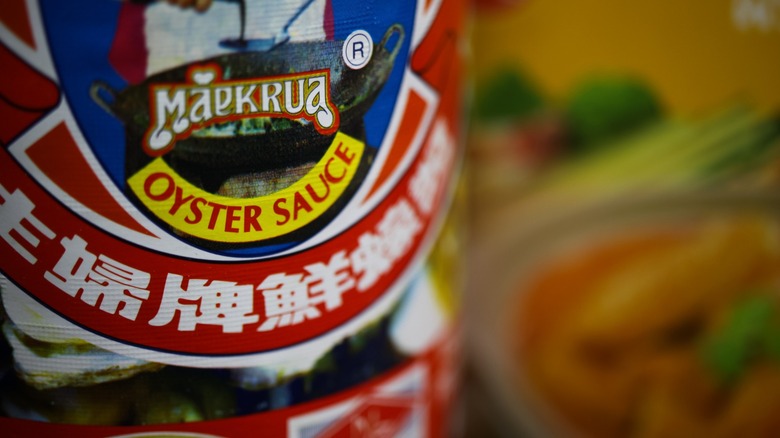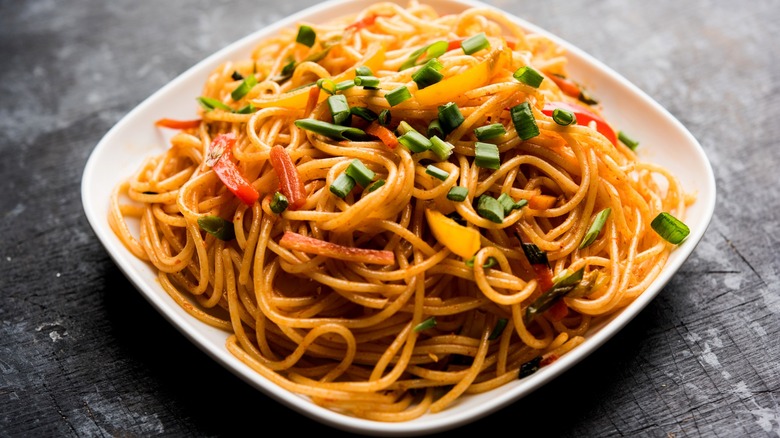The Accidental Origins Of Oyster Sauce
Love it or hate it, oyster sauce, the ubiquitous sweet, salty, syrupy sauce used in Chinese cuisine, is incredibly popular. But do you know where it comes from? It just so happens that oyster sauce is a fairly recent invention. It has a fascinating history that started with a chef's happy accident in the late 19th century.
In this article, we'll dive deep into history to reveal the origins of oyster sauce. We'll also take a look at what this popular Chinese sauce is made from as well as how its popularity has grown throughout the ages.
Finally, we'll look at how oyster sauce is used today in modern Asian cuisine before giving you some ideas for what dishes you can whip up with this delicious, versatile sauce. From chow mein to fried rice and more, there are loads of ways to use oyster sauce in your cooking — including some recipes you might never have tried. You're not limited to using it in Asian recipes, either.
What is oyster sauce?
Perhaps unsurprisingly, oyster sauce does, in fact, contain oysters. The oysters are poached in liquid and then this liquid is boiled until it's syrupy, dark, and caramelized. Soy sauce, sugar, and spices are added to the rich, dark brown sauce — and commercially-sold oyster sauce often adds MSG to the mix, too. The deep color of oyster sauce comes from the Maillard reaction, in which the sugar and protein in the sauce react to heat, becoming darker in color.
Oyster sauce has a rich, complex, umami flavor that's both sweet and savory. It's a pretty intense sauce, so it should be used sparingly as a condiment, marinade, or cooking ingredient. It's a key ingredient in many Chinese dishes ranging from stir fries to fried rice. It's likely that your favorite Chinese takeout dish includes oyster sauce in its list of ingredients.
One thing you'll notice instantly about oyster sauce is that it usually doesn't taste fishy. Because the oysters are poached in liquid which is then reduced and caramelized, the fishiness vanishes, and a sweet, salty, umami flavor is all that remains. Some brands of oyster sauce are definitely fishier than others, though.
Oyster sauce's accidental origins
Oyster sauce is actually a fairly recent invention, dating back to 1888. Lee Kum Sheung, a food stall owner in Nanshui, to the south of Zhuhai in modern-day Guangdong province, was simmering a pot of oyster soup in his stall for his lunch customers. Something — we don't know what — distracted him from the stove and he promptly forgot about the oysters.
When he returned many hours later, the delicious clear soup had reduced to a thick brown paste. Disaster! Or was it? Instead of throwing the mixture into the bin and wasting the expensive oysters, he tasted it. It was delicious — deeply savory, with umami and caramelized sweetness.
After tasting the delicious accident, he decided to sell the sauce to his customers as a rice seasoning. It was an instant hit, and oyster sauce was born. It went on to become so popular in Hong Kong during the 1950s that people were spending around 20% of their monthly salary on the sauce.
Lee Kum Kee is born
Lee was so impressed that he set up his own company, Lee Kum Kee, to sell the newly invented oyster sauce across China. Sales later expanded to Macau, then Hong Kong. By the late 1970s, Lee Kum Kee oyster sauce was being sold in countries around the world, including Japan, Mexico, Thailand, the U.S., and the U.K.
Today, Lee Kum Kee is one of the world's largest food companies, selling more than 200 different varieties of sauces in over 100 regions and countries. However, oyster sauce still remains the star of its lineup.
There are plenty of other brands out there making oyster sauce nowadays, but Lee Kum Kee premium oyster sauce is still the most popular choice for foodies, chefs, and anybody in the food industry. It's still made according to Lee Kum Sheun's original 1888 recipe, too, though this time the results are very much intentional rather than a happy accident.
Only the freshest oysters for Lee Kum Kee
Lee Kum Kee is obsessed about oysters. The brand uses the freshest oysters to make its sauce, grown in self-managed oyster farms. The well-being of the oysters is continually assessed to ensure a safe and hygienic environment.
Not every oyster is lucky enough to make it into a bottle of Lee Kum Kee's premium oyster sauce, though. The brand has strict criteria for the oysters used. They must be two to three years old at the time of harvest.
The oyster extract used in Lee Kum Kee oyster sauce uses fresh oysters cooked and extracted on the day of harvest. The resulting oyster extract undergoes many stages of cooking and refinement before sugar, salt, modified corn starch, wheat flour, color, yeast extract, and flavor enhancers are added to the sauce.
As well as premium oyster sauce, Lee Kum Kee also makes Panda Brand oyster sauce, a gluten-free Panda Brand variant, and a vegetarian stir-fry sauce that can be used as an oyster sauce alternative.
A versatile ingredient in Asian cuisine
With its sweet, rich, savory umami flavor and dark, caramelized color, oyster sauce is used across a wide variety of Asian cuisine. It's a staple ingredient in Asian cooking and something you should always have on your shelf. Once it's opened, we'd recommend keeping oyster sauce in your fridge, particularly if you live somewhere with a warm climate.
Dishes such as beef and broccoli, chow mein, and fried rice all rely on oyster sauce to add depth of flavor and a sticky salty yet sweet note. Chances are your favorite Chinese takeout dish uses oyster sauce, so if you're trying to recreate the same flavor at home, that may be what you're missing.
There are other ways to use oyster sauce too. It's great with stir-fried greens for a delicious side dish. You can add it (sparingly) to plain boiled rice as a sauce. You can even use oyster sauce as a salad dressing, whisked with rice vinegar and sesame oil. Or try mixing it with Chinese black vinegar, water, sugar, and sesame oil to make a tasty dipping sauce for dumplings.
More uses for oyster sauce
Oyster sauce isn't just an essential ingredient for Asian cuisine. You can use it in lots of different ways in the kitchen, making it an incredibly versatile ingredient to have on hand.
Why not try using oyster sauce in place of a beef bouillon cube in all your favorite recipes? Drizzle it over your favorite foods, from fries to noodles, as a condiment — but use it sparingly, as its flavor is intense. Oyster sauce goes well with almost anything including pork, beef, chicken, fish, and vegetables.
You could even use it as a glaze for ribs cooked on the grill, or as a marinade for chicken or pork. If you're whipping up a slow-cooked stew, adding oyster sauce is a great way to enhance the flavor of the meat, bringing savory richness to the gravy. Or you can cut the intensity of oyster sauce by adding other ingredients to make it more palatable. This sauce's delicious flavor is so moreish that you'll soon find yourself adding it to everything.
Toning down oyster sauce's overwhelming flavor
Oyster sauce has such a rich, intense, potent flavor that you only really need a tiny dollop of it in most dishes. If you're not a fan of the sauce's intensity — after all, it can be overpowering — you can balance it out by mixing brown butter with your oyster sauce.
It's easy to do this: simply melt a stick of butter in your pan of choice, let it brown, then add your oyster sauce and perhaps a little soy sauce to season. Caution is needed when browning butter, though, as it can quickly go from a nutty brown color to burnt. Start melting your butter in a cold pan before switching to medium heat, and always keep an eye on it as it melts. Once it crackles and gives off an aromatic, nutty smell, you'll know that the water has evaporated and the butter is ready. At this stage, you should always remove it from the heat before adding the other ingredients.
The resulting sauce is great as a dipping sauce for spring rolls and works well on chicken, fish, or grilled veggies. It also clings well to noodles and pasta for stir-fries and more.
The best oyster sauce brands
Lee Kum Kee — and Panda Brand — aside, there are some other popular brands of oyster sauce that it's worth looking out for the next time you're in your local Asian grocery store. Some of the most popular brands include Healthy Boy, Dynasty, Dragonfly, and Maekrua, and below we'll look at some of the reasons to pick up each of these.
Maekrua is the most popular brand of oyster sauce in Thailand, and you'll likely only find it in larger Asian grocery stores. This oyster sauce isn't as complex as Lee Kum Kee Premium, and it's less sweet and less salty than Panda Brand. Generally, it packs more of a soy sauce flavor, so it's an ideal introduction to oyster sauce if you find the flavor of other brands too intense. Healthy Boy is another Thai brand that's most famous for its soy sauce and Thai sweet chili sauce. Though this seems to be a popular oyster sauce, possibly because it's more affordable than other brands, it can be hard to find and is thinner than most other brands. It's also very salty and doesn't have as much flavor as brands like Lee Kum Kee and Maekrua.
Dynasty Oyster Sauce packs a high percentage of oyster extract, so if you're a fan of the fishy flavor found in oyster sauce, this is the one to get. Its flavor is phenomenal, but only if you like fish. Dragonfly Oyster Sauce remains a favorite with chefs, and its squeeze bottle makes it easy and quick to use. This oyster sauce doesn't contain any MSG and it's less salty than some of the other popular brands. What it lacks in salt it makes up for with intense oyster flavor.
What to cook with oyster sauce
The sky is the limit when it comes to dishes you can make with a bottle of oyster sauce. First up, it's a perfect addition to fried rice and vegetable, chicken, or beef chow mein. You'll also need oyster sauce on hand if you plan on whipping up the takeout favorite beef and broccoli at home. The sauce for this dish is intensely savory, made from oyster sauce, soy sauce, and sugar, with plenty of garlic and ginger.
You can drizzle oyster sauce over grilled vegetables or use it as a stir-fry sauce for vegetables, too. The rich, salty, sweet umami of oyster sauce pairs perfectly with stir-fried eggplant and red pepper.
Oyster sauce is also great in any beef dishes, where its bold flavor and dark color enhance the flavor of the meat. Or pair it with shrimp in a stir-fry where the sticky sweetness and subtle fishy notes boost the flavor of the seafood.









